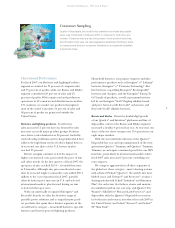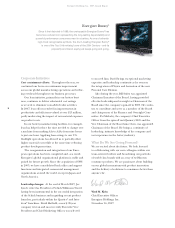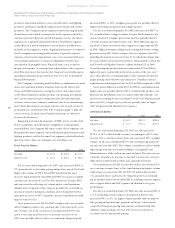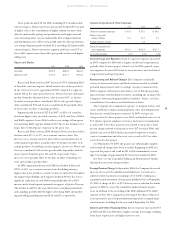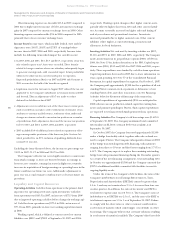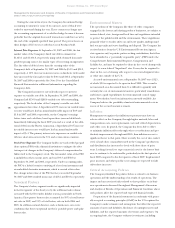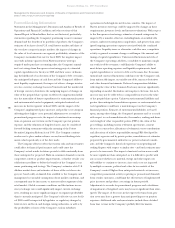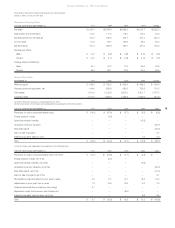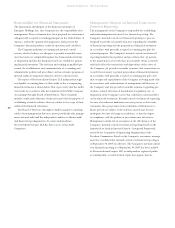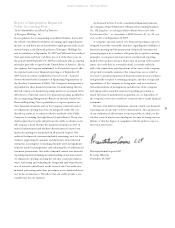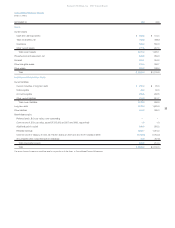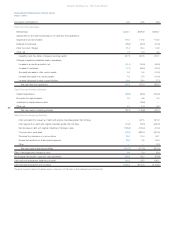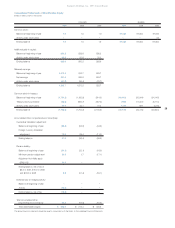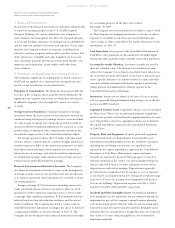Energizer 2007 Annual Report Download - page 19
Download and view the complete annual report
Please find page 19 of the 2007 Energizer annual report below. You can navigate through the pages in the report by either clicking on the pages listed below, or by using the keyword search tool below to find specific information within the annual report.
17
Energizer Holdings, Inc. 2007 Annual Report
those related to customer programs and incentives, product returns,
inventories, intangible assets and other long-lived assets, income
taxes, financing, pensions and other postretirement benefits, and
contingencies. Actual results could differ from those estimates. This
listing is not intended to be a comprehensive list of all of the
Company’s accounting policies.
Revenue Recognition The Company’s revenue is from the sale of
its products. Revenue is recognized when title, ownership and risk
of loss pass to the customer. When discounts are offered to cus-
tomers for early payment, an estimate of such discounts is recorded
as a reduction of net sales in the same period as the sale. Standard
sales terms are final and returns or exchanges are not permitted
unless a special exception is made; reserves are established and
recorded in cases where the right of return does exist for
a particular sale.
The Company offers a variety of programs, primarily to its retail
customers, designed to promote sales of its products. Such pro-
grams require periodic payments and allowances based on esti-
mated results of specific programs and are recorded as a reduction
to net sales. The Company accrues at the time of sale the estimated
total payments and allowances associated with each transaction.
Additionally, the Company offers programs directly to consumers
to promote the sale of its products. Promotions which reduce the
ultimate consumer sale prices are recorded as a reduction of net
sales at the time the promotional offer is made, generally using
estimated redemption and participation levels. Taxes we collect on
behalf of governmental authorities, which are generally included
in the price to the customer, are also recorded as a reduction of
net sales.
The Company continually assesses the adequacy of accruals for
customer and consumer promotional program costs not yet paid.
To the extent total program payments differ from estimates, adjust-
ments may be necessary. Historically, these adjustments have not
been material to annual results.
Pension Plans and Other Postretirement Benefits The determina-
tion of the Company’s obligation and expense for pension and
other postretirement benefits is dependent on certain assumptions
developed by the Company and used by actuaries in calculating
such amounts. Assumptions include, among others, the discount
rate, future salary increases and the expected long-term rate of
return on plan assets. Actual results that differ from assumptions
made are accumulated and amortized over future periods, and
therefore, generally affect the Company’s recognized expense and
recorded obligation in future periods. Significant differences in
actual experience or significant changes in assumptions may
materially affect pension and other postretirement obligations.
In determining the discount rate, the Company uses the yield on
high-quality bonds that coincides with the cash flows of its plans’
estimated payouts. For the U.S. plans, which represent the
Company’s most significant obligations, the CitiGroup yield curve
is used in determining the discount rates.
Of the assumptions listed above, changes in the expected assets
return have the most significant impact on the Company’s annual
earnings prospectively. A one percentage point decrease or
increase in expected assets return would decrease or increase the
Company’s pre-tax pension expense by $8.0.
As allowed under U.S. GAAP, the Company’s U.S. qualified pen-
sion plan uses Market Related Value (MRV), which recognizes mar-
ket appreciation or depreciation in the portfolio over five years so
it reduces the short-term impact of market fluctuations.
Valuation of Long-Lived Assets The Company periodically evalu-
ates its long-lived assets, including goodwill and intangible assets,
for potential impairment indicators. Judgments regarding the exis-
tence of impairment indicators are based on legal factors, market
conditions and operational performance. Future events could
cause the Company to conclude that impairment indicators exist.
The Company uses the discounted cash flows method to determine
if impairment exists. This requires management to make assump-
tions regarding future income, working capital and discount rates,
which would affect the impairment calculation.
Income Taxes The Company estimates income taxes and the
income tax rate in each jurisdiction that it operates. This involves
estimating taxable earnings, specific taxable and deductible items,
the likelihood of generating sufficient future taxable income to
utilize deferred tax assets and possible exposures related to future
tax audits. Deferred tax assets are evaluated on a subsidiary by sub-
sidiary basis for realizability. Valuation allowances are established
when the realization is not deemed to be more likely than not.
Future performance is monitored, and when objectively measura-
ble operating trends change, adjustments are made to the valua-
tion allowances accordingly. To the extent the estimates described
above change, adjustments to income taxes are made in the period
in which the estimate is changed.
Acquisitions The Company uses the purchase method, which
requires the allocation of the cost of an acquired business to the
assets acquired and liabilities assumed based on their estimated fair
values at the date of acquisition. The excess value of the cost of an
acquired business over the fair value of the assets acquired and
liabilities assumed is recognized as goodwill. The valuation of the
acquired assets and liabilities will impact the determination of
future operating results. The Company uses a variety of information
sources to determine the value of acquired assets and liabilities
including: third-party appraisers for the values and lives of property,
identifiable intangibles and inventories, actuaries for defined bene-
fit retirement plans and legal counsel or other experts to assess the
obligations associated with legal, environmental or other claims.
Accounting Standards
See discussion in Note 2 to the Consolidated Financial Statements
related to recently issued accounting standards.


